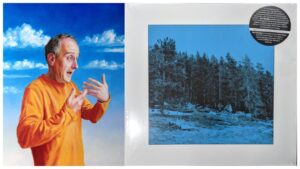In Draft No 4, the great writer John McPhee describes how his English teacher insisted every piece of student writing began with a sketch of contents and structure. This is mine. In a few hundred words time, you can judge if I have kept to it.

My English teacher was equally prescriptive but more prosaic: “define your terms”. So, here goes.
Every third Tuesday, between September 2021 and January 2022, about a dozen of us met on zoom for an hour and a half. Some were people who stammered; others, speech and language professionals; some both; all of us keen to explore how we think and talk about stammering — and how those ways of thinking and talking could be developed.
These Every-Third-Tuesdays proved to be bewilderingly exhilarating sessions. They were not training. They most definitely were not therapy. They were patient, respectful, deep explorations of so many questions: What does it mean to stammer in today’s society? Why is fluency revered and should it be? What is the purpose of speech therapy? Is there a stammering way of seeing and portraying the world? Should people who stammer seek fluency? Or should they resist, and if so, how?
I do not know what Sam, Patrick, and the others were hoping for or expecting from the conversations, but I do remember what I was looking for…
As someone who has stammered all his life (from unavoidably obvious to carefully covert and much in between), and who had avoided thinking about stammering for many decades (denial and avoidance were my main coping strategies), I now wanted answers. Answers that were:
- Quick
- Easy
- Complete, covering all aspects of how to change society and our perceptions of stammering.
Reader, let me disappoint you now. This did not happen.
Instead, Sam and Patrick, like the teachers who inspired me and John McPhee, started with an idea of structure and subject matter, and then, with expert, hands-off facilitation, let the conversations and ideas grow and develop as the weeks passed.
Two sessions had guest speakers: artist Paul Aston, who talked about visualising both the moment and the feeling of stammering, and musician JJJJJerome Ellis, who explored a range of ideas from the similarity of water and disfluency to the need to reclaim space and time.
For too long, I had thought that someone who stammered might be creative in order to escape the stammer, to prove ability in a different arena. Paul Aston and JJJJJerome Ellis surprised and moved me, completely reversing my restricted view of the world and showing that a stammer could be part of you and your art in a way that was rich, thoughtful, and powerful.

Self portrait by Paul Aston (Instagram @PaulAstonPainter) | JJJJJerome Ellis album “The Clearing”
In the track Dysfluent Waters from his album The Clearing, JJJJJerome asks:
Is the stream of my disfluent
speech remembering where it used to be?
Are my glottal blocks
floods?
What if fluency is like straightening the Mississippi, severing orality from a prior fullness?
These questions and others asked by the artists tied in closely with those raised when we looked at the thinking and writing of theorists and activists.
Poignantly, we celebrated Lynne Mackie’s life by discussing her elegant dissection (https://www.youtube.com/watch?v=FF1H8a2hfMg) of the role played by stammering in the TV series Bridgerton.
Vivian Sisskin’s views (https://www.redefiningstammering.co.uk/power-imbalances-and-stuttering-the-double-empathy-problem/) on the power imbalances within therapy had the discussion rocking back and forth: was it society, speech and language professionals, or people who stammered who had to adjust their thinking?
And then there was the glorious raucous scattergun of writing within the DidIStutter? website — different activists questioning stammering and gender, stammering and ableism, anger, power, interruptions, labelling, and more.
We were a circle of voices babbling together and letting the ideas flow. Like JJJJJerome’s tumbling water.

But under the surface, then and in the months since, something different was happening: second order ideas and connections are bubbling, burbling, away. More than any teacher’s outline could predict.
Beside my laptop is this little bowl.

It’s hand made, rough, cracked, chipped, at least fifty years old, made by an Englishman who studied Japanese ideas, such as Wabi Sabi, the idea that all natural things are imperfect and that imperfection should be respected and admired.
These sessions have helped me understand that we do not need to chase a false perfect speech that we think others expect. We each have choices and the right to speak as we choose.
I also realised that good questions are better than quick’n’easy answers (although trying to change the world is not a bad idea). And that I was not being given a map. I was drawing my own map, perhaps helping others draw theirs.

And I am still working on my map: What would I say to a ten-, twenty-, thirty-year old me who wanted therapy? Is stammering gain or pride relevant to everyone? Where do I ask society to change and where do I try to change myself? Can I become a stammering artist?
With so much being discussed but still unresolved, what should happen next?
Perhaps, we don’t need a student essay outline, a great plan for the future. Perhaps these conversations show another way.
In her forward to Hope in the Dark, the wonderful essayist Rebecca Solnit describes how efforts to change society appear to be isolated and spontaneous but in fact depend on people talking and working together unseen, making connections, sharing ideas, sharpening ideas — just as the mushrooms we see spring up overnight are only the visible part of a vast underground network of roots threaded and tangled together.

I quite like the idea of being one of Sam and Patrick’s mushrooms.
(Alternative ending: I quite like the idea of being a mushroom who stammers.)
Jack Nicholas

Image Credits:
Essay sketchnote: JN
Paul Aston: Paul Aston
The Clearing album cover: JJJJJerome Ellis
Water: Noah Usrey Unsplash
Treasure map: https://upload.wikimedia.org/wikipedia/commons/c/c6/Treasure-island-map.jpg with JN additions.
Mushrooms: Irish83 Unsplash